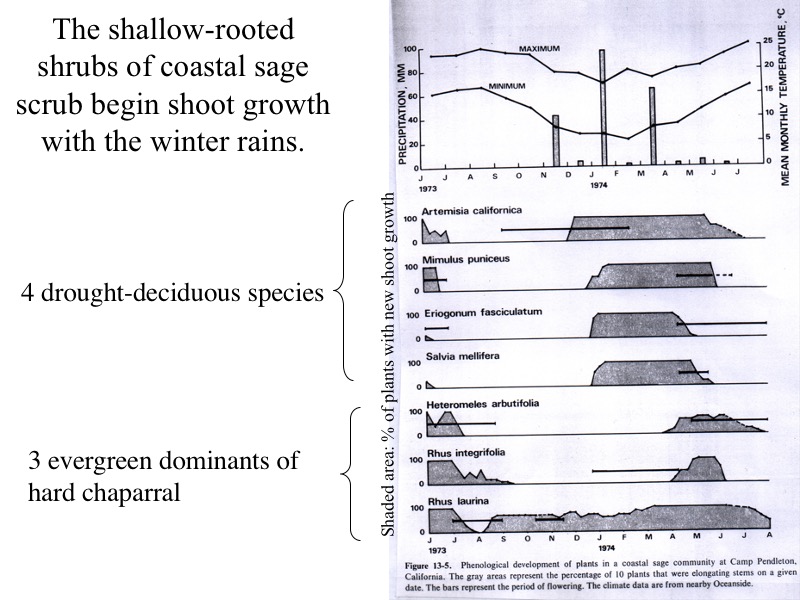Different seasonal responses
Changes in xylem water potential
Xylem water potential is a measure of the tension in the water column in the xylem. A more negative water potential indicates a greater tension. Both evaporative demand by leaves and a low water supply rate from roots can increase tension (lower water potential). The highest xylem water potential that a plant experiences during the day is right before dawn, after stomata have been shut all night, stopping evaporative demand.
Early research compared seasonal changes in the xylem water potential of Heteromeles arbutifolia (toyon), an evergreen shrub of chaparral, to that of Salvia mellifera (black sage), a drought-decidous dominant of coastal sage scrub.

Check your ability to understand these data:
Changes in photosynthesis
Not only do drought-deciduous shrubs lose leaf area during the summer, but the photosynthetic rate of the remaining leaf area goes down (that is, the rate of carbon uptake per cm2 of leaf area per unit time). Spring leaves are not only larger, but they have a higher rate of photosynthesis per unit leaf area, than summer leaves.

Can you interpret these data?
Season of shoot growth
Normally, plant growth is best when temperatures are reasonably warm (not too cold and not frying). The challenge for plants living in a mediterranean climate is that, when water is readily available, temperatures are too cool for maximal growth, but as temperatures warm up, the soil starts to dry.
Deep-rooted plants have access to more stored soil water through the summer drought, so they can continue photosynthesizing and growing later into spring and early summer.
However, because the dominants of coastal sage scrub are shallow rooted, they...
- Run out of water in late spring/early summer, causing them to..
- Drop most of their leaf area, and...
- Reduce the photosynthetic rate of their remaining leaf area
Therefore, they cannot grow as long into the late spring and summer as the evergreen chaparral dominants.
These considerations appear to have selected for differences in when different shrub types start growing in the season. Look at the figure below. It shows when different species begin producing new stems (shown as the percent of plants in a species with new shoot growth, censused repeatedly over the year).

Understand the graph above: